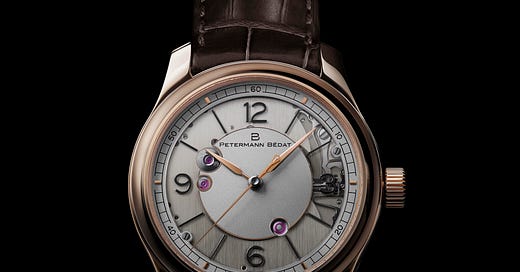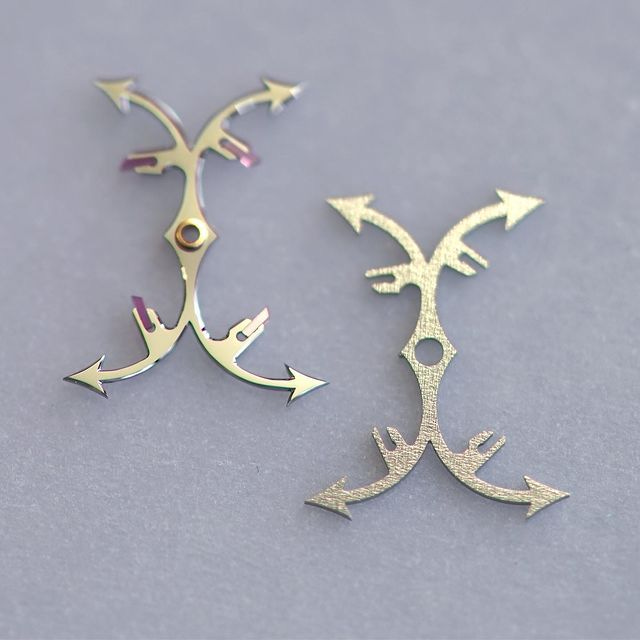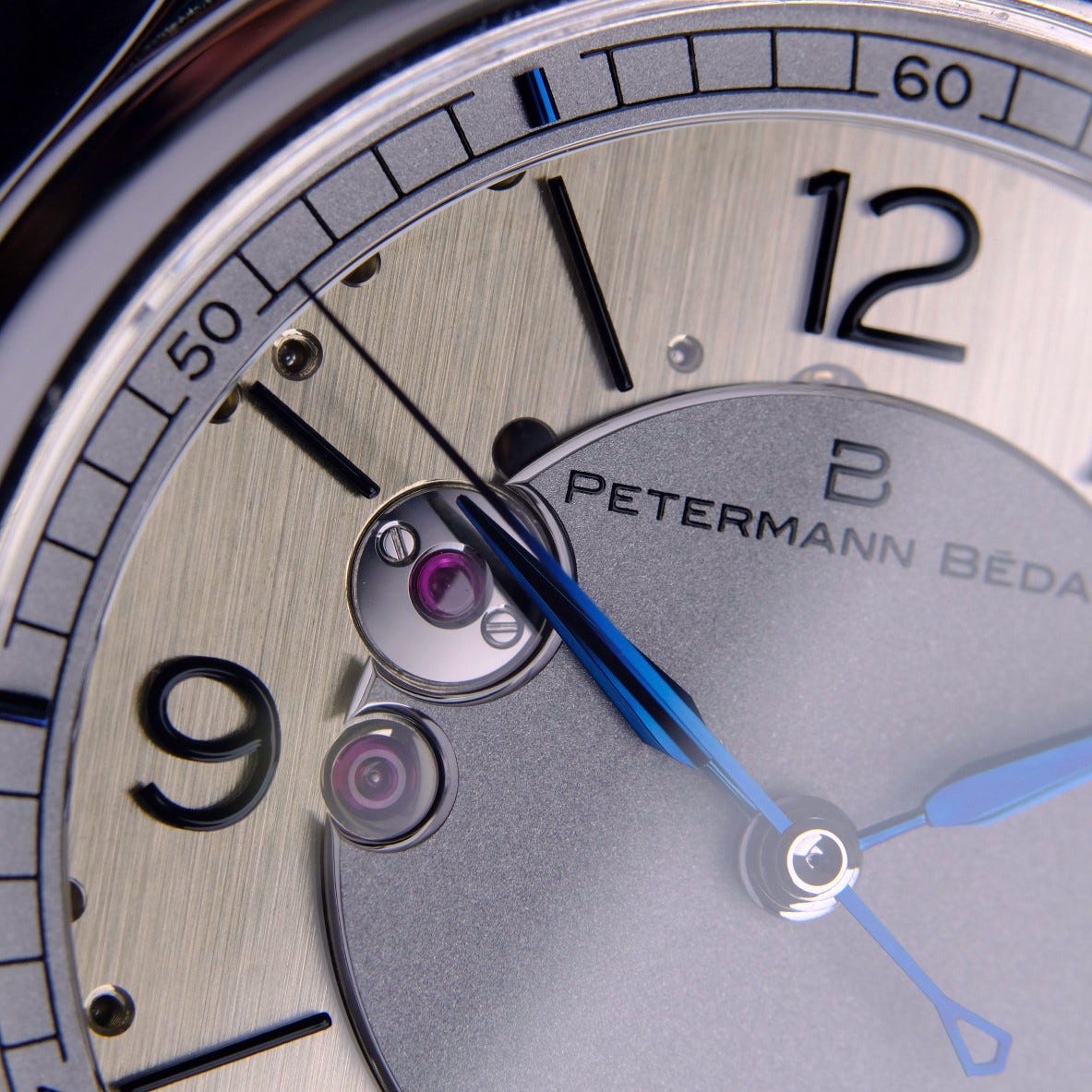In Conversation with Petermann Bédat: Switzerland's Most Exciting Independent Brand
Talking watchmaking, independence and deadbeat seconds with two of Switzerland’s most impressive young watchmakers
No gift guide from Rescapement this year, or any year. Instead, a chat with two of Switzerland’s finest young watchmakers.
Petermann Bédat: Young, independent, and a bit ironic
“The watchmaking industry is very serious, but we are young. We love watchmaking, but we want to do it in a different way. We’re not in the mountains with a pipe in our mouths. We want to show we can be young and still make nice watches,” Gael Petermann, one half of Petermann Bédat, tells me. Gael, along with long-time friend and watchmaking school classmate Florian Bédat, set out independently in 2017.
The pair’s first effort is the Petermann Bédat 1967 Deadbeat Seconds, a time-only wristwatch with a deadbeat seconds mechanism. Unlike a typical mechanical watch, in which the seconds hand sweeps in increments of a second, a deadbeat seconds marks a second with a discreet tick each second.
While it may feel like Petermann Bédat burst onto the scene in 2020 with the 1967, highlighted by a Grand Prix d’Horologerie de Geneve (GPHG) win for Horological Revelation Prize, in truth the story stretches back to 2007 when the pair of now 28-year-olds met at watchmaking school in Geneva.
Acquiring the tools
Gael and Florian first met when they entered the Watchmaking School of Geneva in 2007 at the age of 15.
“When I was 15, we had to choose between high school or apprenticeship. I always wanted to do something with my hands. I did different internships with different manufacturers. One day, I went to Vacheron Constantin and really liked it, so I tried the test for watchmaking school in Geneva,” Florian said. He explained that the first year of school is mostly micromechanics, with students crafting their own tools that they will use during their studies. Even now, Florian says he uses some of these tools. By the final year of school, students mostly work in the watchmaking school’s service center, repairing watches and clocks.
After watchmaking school, the two went in separate directions, but both working for large manufacturers: Florian first to Harry Winston, Gael to A. Lange & Sohne. Florian spent two-and-a-half years at Harry Winston, starting by working on encasings, eventually moving up to work on small complications. Then, in 2013, Swatch Group acquired Harry Winston.
“Before, it was interesting because it was more watchmaking, learning how to regulate and control things. But when Swatch Group bought Harry Winston it became less interesting,” Florian said, explaining that Swatch moved Harry Winston’s assembly of movements to Blancpain (another Swatch-owned brand). That’s when Florian decided to reconnect with his old friend, Gael.
“Gael had already been at Lange for two years, and he told me how he was already assembling perpetual calendars and advancing very quickly,” Florian said, comparing Gael’s experience to his. Besides learning to work on complex movements, Gael was also learning the importance of controlling his work.
“For example, I did a small internship at Patek Philippe, and if you scratch a bridge, it’s not good but you can replace the bridge no problem. You’ll have lost maybe 5 minutes because you have to disassemble and put the new bridge on. But at Lange, if you scratch a bridge, you have to disassemble everything, all the gold chatons, all the screws, then go to the departments where they make the Geneva stripes, put back the chatons and screws. You can lose 4-5 hours just because you made a scratch on your bridge. So you pay close attention,” Gael explained.
From Geneva to Glashutte
Educated in Switzerland, but both having worked at Glashutte, Germany-based A. Lange, the Petermann Bédat pair also have unique perspective on the differences between German and Swiss watchmaking.
“At Lange, they put a lot of trust in you the watchmaker. I saw the difference between me and Gael: when I was at Harry Winston, my evolution was slower than Gael’s. He was already doing perpetual calendars, while I was assembling small complications. For me, it was a huge evolution. At Lange, almost every day you learn something new and you can see a lot of things in a very short time,” Florian said.
Gael added: “Patek has really good machines, and when they make a part, it’s already very good. At Lange, you’d have to adjust it, which took a lot of time. To me, this was the biggest difference I could see between Swiss and German, but obviously, all companies in Switzerland are not Patek and all companies in Germany are not Lange.”
Independent thinking
Gael says he didn’t set out to become independent, but he became connected with Svend Anderson, the co-founder of AHCI, an association of independent watchmakers. Anderson gave Gael — then 22 years old — the opportunity to set up independently in his workshop.
A couple of years later, Florian came back to Switzerland from Germany. A few months after his return, Gael came to Florian with an idea: that the two set up an independent workshop in Renens, Switzerland. The idea wasn’t just a whim, though: the pair would have the opportunity to set up shop next door to Dominique Renaud, one-half of famed movement manufacture Renaud & Papi. Now owned by Audemars Piguet, the company served as a training ground for some of the biggest names in modern horology: Grönefeld, Grubel, Forsey (not to mention receiving important commissions from Richard Mille, Lange, among dozens of other brands).
“For both of us, we went independent because of the opportunities we got. It wasn’t our plan, but these nice surprises and opportunities led us to go independent,” Florian said.
Now that Petermann Bédat is a full-fledged independent operation, the two are clear on the purpose of their brand.
“What we are trying to do is what we learned and continue to learn by restoring. We want to make wristwatches as beautiful as pocket watches. We love pocket watches; the handwork was incredible. Our goal is to put these old designs and movement finishings in a wristwatch, but with 21st-century design,” Gael said.
Petermann Bédat’s first wristwatch has certainly achieved this goal. The caliber 171 inside the 1967 Deadbeat Seconds draws inspiration from a movement the two watchmakers learned about in school, a deadbeat seconds tourbillon pocket watch designed by Robert Gafner.
“We wanted to make a simple, three-hand watch, but when we had the opportunity to work with Dominique [Renaud], we thought why not add a small complication?” Florian said, adding that he’d always been fascinated by dead-beat seconds mechanisms he’d come across doing restoration work for Christie’s. The deadbeat seconds mechanism they developed sits on top of the movement, allowing the pair to put their (substantial) skill in movement decoration on full display.
Underneath the deadbeat seconds mechanism sits a large “Breguet-style” balance wheel. The plates and bridges are made of German silver, with the three-quarter plate indicating their deep respect for the watchmaking they learned in Saxonia. Entirely decorated by hand, the pair says it takes 340 hours to finish a timepiece. Thirty-five of these hours are dedicated to the uniquely-shaped deadbeat seconds anchor, with its four pointed arrows.
Take a look at the before and after photo of the anchor above, and it’s not hard to understand why this single piece takes so long (before, right; after, left). “The most difficult thing when you bevel a piece is to have the same bevel everywhere. With the arrows, it’s very difficult to come in with your file and decorate it. One of the most frustrating parts is when you have to polish it. For example, sometimes you’ll have to polish more on one arrow versus the other, so the bevel won’t be the same. So you’ll have to take the file to make the bevel a bit bigger, then re-polish until you control everything just right,” Gael said.
This deadbeat seconds mechanism is also what gives the watch its name: 1967 is the year the first quartz prototypes started ticking in both Switzerland and Japan. The pair said that a lot of people told them they were crazy for putting all those hours into a deadbeat seconds to make a watch that ticks like quartz.
“The watchmaking industry is very serious,” Gael said. “That’s a good thing, but we are young. We are not in Geneva or the Valle de Joux; our view is directly over a train station. That’s why we thought it’d be nice to be a bit ironic.”
As young guys in a traditional industry, Florian and Gael say they’re also focused on educating people about watchmaking. “Not just on Instagram, where you can see all this watches shit,” Gael said. “But, why this watch is cheap, why another is expensive.”
To that point, the pair is especially proud of some of the heritage techniques they use. For example, the deep matte finish of the deadbeat seconds bridge is achieved with poudre de levant, a technique using olive oil that had been traditionally used on pocket watches, but largely forgotten by modern watchmakers.
Petermann Bédat first released the prototype of its 1967 Deadbeat Seconds more than a year ago. While the movement initially received positive reception, the dial garnered criticism and left something to be desired, feeling a bit too simple. Criticism in hand, the pair went back to the drawing board to enlist the help of designer Barth Nussbaumer to re-work the dial.
“We decided we had to change the dial to pay tribute to the many hours of work that we put into the movement,” Florian said. The result is a “sector” dial with a sapphire chapter ring that puts the jewels of the movement on full display. A playful balance of classic and modern, as has become the signature of the young watchmakers.
GPHG perhaps made the most adept analogy: “Petermann Bédat's design is a subtle blend of Gael and Florian's taste, a balanced cocktail made out of 19th century technical and aesthetic influences for the base notes, some mid-20th century design codes for the body and a modern zest. The outcome is a crisp point of view on fine watchmaking.” Sloshed metaphors aside, the 1967 Deadbeat Seconds is a breath of fresh air in the watch industry: Petermann Bédat and the work of these two young watchmakers have truly made me excited about the future of watchmaking.
As for what’s next for Peterman Bédat?
“For now, it’s too early. When we released the Deadbeat Seconds, we didn’t know how many would sell. When we sold all 20, we knew we couldn’t stop there. We changed the design of the dial so it has its own identity, and now we want to do the same on the case,” Gael said. After that? “In 2022, we’ll release a new complication.”
Rescapement is a weekly newsletter about watches. Subscribe now to get this delivered to your inbox every Sunday. 👇
Petermann Bédat, cont’d.
Last month, A Collected Man made a short film about Gael and Florian. It’s a great video, taking you into the homes and workshop of the watchmakers. (That it somehow has <1k views is tragic.)
Through the Wire
💁♀️ Vogue: Why I’m Buying My First Watch
A great article from Vogue on buying a traditional watch to avoid staring into an iPhone, hypnotized by the digital abyss of Instagram and work emails.:
“This is where my recent desire to buy a classic watch, and streamline my life, comes in. Lately, I’ve been imagining a whole watch-wearing alter ego for myself: a woman who is calm, poised, and tech-free…In fact, any woman with a watch, a good watch, connotes some sort of otherworldly attitude of composure and taste.”
The article also hints at the potential power of resale sites like TheRealReal and Chrono24 to get newcomers interested in pre-owned and vintage.
🧥 High Snobiety: When Fashion Brands Become Media
A report from High Snobiety that felt prescient given the conversations happening in the watch industry, across brands and publications:
“Storytelling is the most powerful tool fashion brands have — it’s how they’ve cemented their leading status in contemporary culture and why today all roads lead to them. It’s now time for brands, regardless of size, to stop treating content as an afterthought and see it as their biggest opportunity for growth.”
♠️ New Consumer: Hodinkee and the New Luxury
The New Consumer explores Hodinkee’s rise and approach to watches and the luxury industry, with some insights from new CEO Toby Bateman (formerly of Mr. Porter):
"In particular with the younger generation, with Gen. Z, there’s less and less emphasis being placed on the status nature of products. There’s more and more interest in: How am I going to spend this money? I want to know—regardless of whether I’m spending $1,000 or $20,000—as a consumer, I want to know that I’m putting that money into a brand that I can identify with. It says something about me. I understand the history of the brand. I think the brand is demonstrating strong values ethically and socially and environmentally. These are fast-emerging as the most important criteria in luxury goods."
📈 Business Insider takes a look at the watch market and chats with a few dealers who recommend 11 watches to “invest” in.
Okay ciao! -Tony
Rescapement is a weekly newsletter about watches (mostly vintage-ish). Give us a subscribe to get this email delivered to your inbox every Sunday morning:










I enjoyed reading this interview very much! I only heard from them from this year's GPHG awards and it is great to have such an in-depth coverage. They are certainly rising stars that we may follow. Thanks and happy holidays!